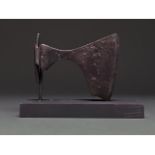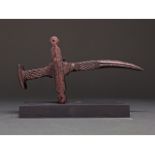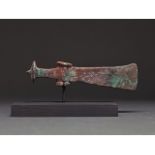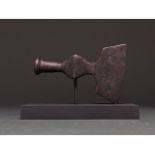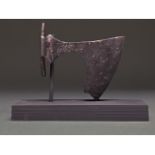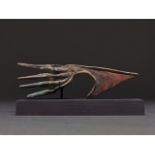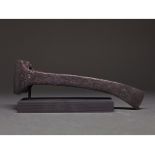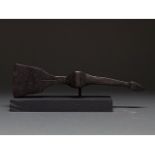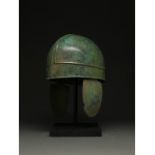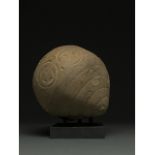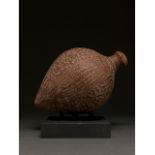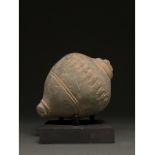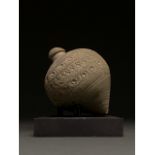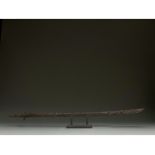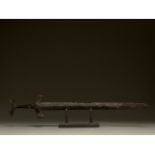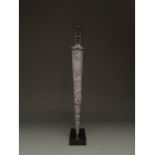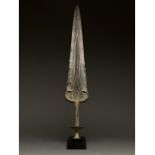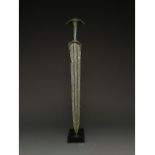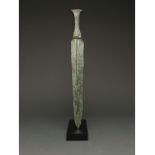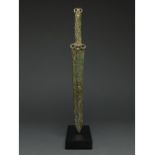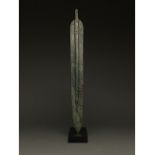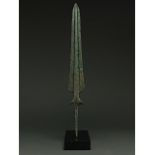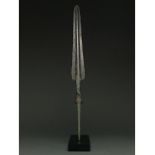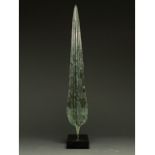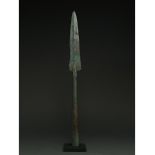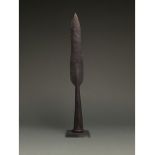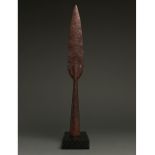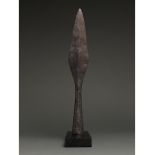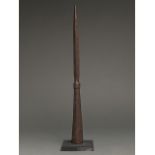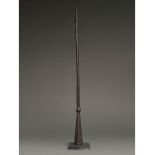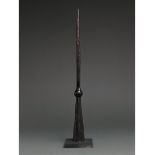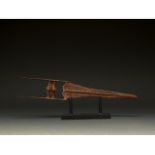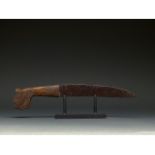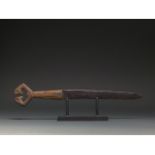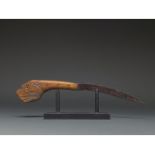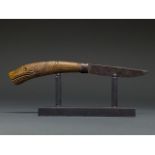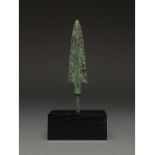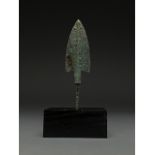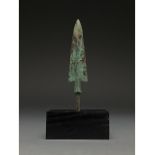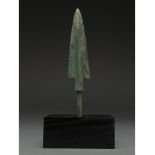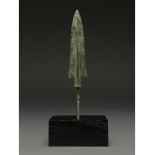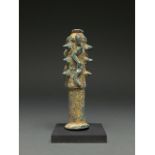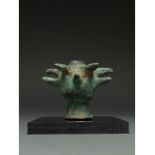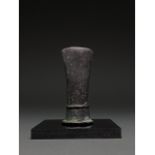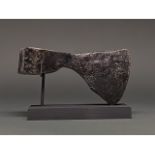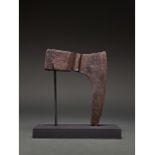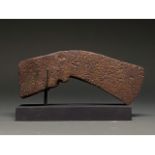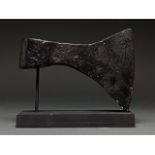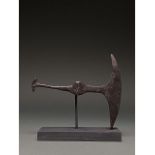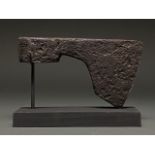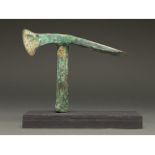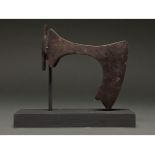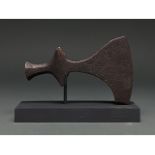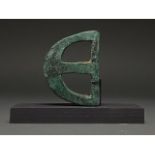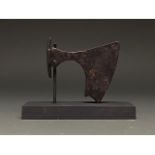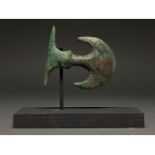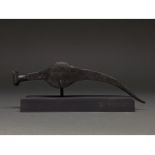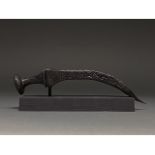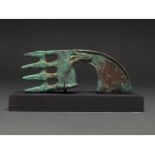Refine your search
Estimate
Category
- Arms, Armour & Militaria (123)
- Jewellery (90)
- Greek, Roman, Egyptian & Other Antiquities (39)
- Sculpture (20)
- Collectables (15)
- Scientific Instruments (14)
- Glassware (13)
- Salvage & Architectural Antiques (12)
- Metalware (10)
- Coins (9)
- Ceramics (4)
- Vintage Fashion (4)
- Musical Instruments & Memorabilia (3)
- Silver & Silver-plated items (2)
- Sporting Memorabilia & Equipment (2)
- Textiles (2)
- Books & Periodicals (1)
- Stamps (1)
- Tools (1)
- Wines & Spirits (1)
Filtered by:
- Item Type
- List
- Grid
A subscription to the Price Guide is required to view results for auctions ten days or older. Click here for more information
VIKING IRON BATTLE BEARDED AXE
c. 900-1100 AD. Viking age. An iron bearded axe head with an squat, heavy blade and a socket. The bearded axe, or Skeggøx (from Old Norse Skegg, ...
1300-1400 AD. Medieval European. Iron war hammer with slightly curved, square face, long throat and neck, high, rectangular head with circular pro...
C. 2000-700 BC, Luristan culture. Bronze axe head with short blade, wedge-shaped cheek, reinforced socket and spiked butt. Bronze weaponry product...
900-1100 AD. Viking Age. Iron battle axe with tall, square blade, tapering cheek, rounded poll and a heavy, round-faced hammerhead on the reverse....
VIKING IRON BATTLE BEARDED AXE
c. 900-1100 AD. Viking age. An iron bearded axe head with an squat, heavy blade and a socket. The bearded axe, or Skeggøx (from Old Norse Skegg, ...
C. 2000-700 BC, Luristan culture. Bronze battle axe head with short, triangular blade, thinned cheek and a four-spiked butt. Bronze weaponry produ...
LARGE VIKING IRON BATTLE AXE
900-1100 AD. Viking Age. Iron battle axe with short, curved blade, long cheek and poll reinforced with thick flanges. The era known as the Viking ...
900-1100 AD. Viking Age. Iron battle axe with squat, curved blade, narrow cheek, rounded poll and an elongated, pointed spike on the reverse. The ...
c. 500-300 BC, Classical down to Alexander the Great period. This beautiful two-part Chalcidian helmet features a high-crested brown and hinged ch...
900-1200 AD, Byzantine. Decorated Byzantine "fire grenade" comprising a brownish-cream ceramic vessel with a spheroconical body; repeating stamped...
900-1200 AD, Byzantine. Decorated Byzantine "fire grenade" comprising a brownish-red ceramic vessel with a spheroconical body, short, cylindrical ...
900-1200 AD, Byzantine. Decorated Byzantine "fire grenade" comprising a cream ceramic vessel with a spheroconical body, short, squat neck and dome...
900-1200 AD, Byzantine. Decorated Byzantine "fire grenade" comprising a cream ceramic vessel with a spheroconical body, and short, squat neck; inc...
900-1200 AD, Byzantine. Decorated Byzantine "fire grenade" comprising a cream vessel with a spheroconical body, short, squat cylindrical neck and ...
C. 600 AD. Migration Period. A long iron sword with a long, pointed, bevelled blade, a rectangular guard, and a long, rectangular tang for affixin...
600-400 BC. Scythian. Iron sword with pointed, bevelled blade, flaring guard, elongated handle and fish-tail shaped pommel. The guard and the pomm...
600-400 BC. Scythian. A rare iron Acinaces-type sword with pointed, elongated triangular blade, narrow V-shaped, unusual openwork rectangular hand...
1200-700 BC, Greek Archaic Period. This beautiful bronze sword has a leaf-shaped, bevelled blade with a fuller or “blood grooveâ€, curving attac...
1200-700 BC, Greek Archaic Period. This beautiful bronze sword has a tapering, bevelled blade with raised midrib, an integral cylindrical handle a...
1200-700 BC, Greek Archaic Period. This superb bronze sword has a tapering, bevelled blade with raised midrib and an integral handle. Bronze weapo...
c. 475 BC – 221 BC. Warring States Period. Bronze spearhead with leaf-shaped, lentoid-section blade and central midrib. The guard comprises an o...
1200-700 BC, Greek Archaic Period. This beautiful bronze sword has a tapering, bevelled blade with raised midrib and a sub-rectangular handle for ...
1200-700 BC, Greek Archaic Period. This bronze speak has a tapering, bevelled blade with raised midrib, a V-shaped guard and a long, tapering tang...
1200-700 BC, Greek Archaic Period. This bronze speak has a tapering, bevelled blade with raised midrib, a V-shaped guard and a long, tapering tang...
1200-700 BC, Greek Archaic Period. This beautiful bronze sword has a tapering, bevelled blade with raised midrib and a sub-rectangular handle for ...
c. 800-600 BC, Greek Hoplite Period, A beautiful bronze hoplite spear with a leaf-shaped blade and conical socket. Bronze weaponry production flou...
LARGE VIKING SOCKETED SPEAR
900-1100 AD. Viking Age. Large iron spearhead with pointed, leaf-shape blade, flaring neck and circular socket. The era known as the Viking age la...
LARGE VIKING SOCKETED SPEAR
900-1100 AD. Viking Age. Large iron spearhead with pointed, leaf-shaped blade, flaring neck and circular socket. The era known as the Viking age l...
LARGE VIKING SOCKETED SPEAR
900-1100 AD. Viking Age. Large iron spearhead with pointed, lozenge-shaped blade, flaring neck and circular socket. The era known as the Viking ag...
900-1100 AD. Viking Age. Iron lancehead with pointed, pyramidal head, flaring neck and circular socket. The era known as the Viking age lasted for...
C. 100-300 AD. Roman. A rare, large iron pilum spear head with a barbed, triangular blade, a long, narrow neck, and a spherical protrusion just ab...
C. 100-300 AD. Roman. A rare, large iron pilum spear head with a narrow point, a long, narrow neck, and a spherical protrusion just above a robust...
C. 1600 – 1800 AD. Post-medieval. An iron Katar dagger or knuckleduster comprising a two-part, bulging grip with guard and leaf-shaped blade wit...
C. 900 AD. Viking age. Medieval Scandinavian, pointed iron knife; expertly cleaned and conserved with hand-carved, reconstructed bone handle depic...
C. 900 AD. Viking age. Medieval Scandinavian, pointed iron knife with leaf-shaped blade; expertly cleaned and conserved with hand-carved, reconstr...
C. 900 AD. Viking age. Medieval Scandinavian, pointed iron knife with an elongated, curved blade; expertly cleaned and conserved with hand-carved,...
C. 900 AD. Viking age. Medieval Scandinavian, pointed iron knife with a short, curved blade; expertly cleaned and conserved with hand-carved, reco...
ANCIENT BRONZE SPEAR ON STAND
1200-700 BC, Greek Archaic Period. This bronze speak has a tapering, bevelled blade with raised midrib, a broad neck and a tang for insertion into...
ANCIENT BRONZE SPEAR ON STAND
1200-700 BC, Greek Archaic Period. This bronze speak has a broad, leaf-shaped blade with raised midrib, and a tang for insertion into a haft. Bron...
ANCIENT BRONZE SPEAR ON STAND
1200-700 BC, Greek Archaic Period. This bronze speak has a leaf-shaped blade with raised midrib and barbs, road neck and a tang for insertion into...
ANCIENT BRONZE SPEAR ON STAND
1200-700 BC, Greek Archaic Period. This bronze spear has a leaf-shaped blade with raised midrib and barbs, board neck and a tang for insertion int...
ANCIENT BRONZE SPEAR ON STAND
1200-700 BC, Greek Archaic Period. This bronze speak has a leaf-shaped blade with raised midrib and barbs, broad neck and a tang for insertion int...
C. 2000-700 BC, Luristan culture. A Luristan cast bronze mace head with a domed end, and a cylindrical body featuring neat rows of spikes running ...
C. 2000-700 BC, Luristan culture. A Luristan cast bronze mace head with a domed tip, globular body and conical neck; the body is covered in numero...
C. 1000-800 BC, Celtic Bronze Age. Bronze axe head with short curved blade, elongated, cylindrical cheek with a single rib running around the outs...
900-1100 AD. Viking Age. Iron battle axe with curved blade, tapering cheek, heavy, reinforced poll and socket. The era known as the Viking age las...
900-1100 AD. Viking Age. Iron battle axe with elongated, curving blade, tapering cheek and reinforced poll. An incised star motif is visible on th...
900-1100 AD. Viking Age. Iron battle axe with short, curved blade, arched cheek, heavy poll and socket. An incised chevron pattern is visible on t...
900-1100 AD. Viking Age. Iron battle axe with a wide, fan-shaped blade, tapering cheek, heavy poll and socket. The era known as the Viking age las...
900-1100 AD. Viking Age. Rare iron battle axe with a wide, crescentic blade, tapering cheek, reinforced poll and socket. On the rear, a hammerhead...
VIKING IRON BATTLE AXE HEAD
900-1100 AD. Viking Age. Iron battle axe with elongated, straight blade, tapering cheek and reinforced poll. The bearded axe, or Skeggøx (from Ol...
C. 2000-700 BC, Luristan culture. A Luristan axe head with a short, curved blade, elongated, tapering cheek, and spike on the reverse. A cylindric...
VIKING IRON BATTLE AXE HEAD
900-1100 AD. Viking Age. Iron battle axe with elongated, curved blade, tapering cheek, reinforced poll and rectangular flanges for attachment to t...
900-1100 AD. Viking Age. Rare iron battle axe with a wide, curved blade, tapering cheek, diamond-shaped poll and socket. On the rear, a rounded ha...
RARE BRONZE AGE AMLASH AXE HEAD
c. 2000-1000 BC, Amlash culture. Rare bronze axe with crescentic-shaped blade and openwork chee. The Amlash culture refers to an assortment of his...
900-1100 AD. Viking Age. Superb example of an iron battle axe with elongated, curved blade, tapering cheek, reinforced poll and rectangular flange...
C. 2000-700 BC, Luristan culture. A Luristan bronze axe head with a crescentic blade, narrow cheek and rounded socket with sub-rectangular flanges...
1300-1400 AD. Medieval European. Iron war hammer with square face, short cylindrical throat, square neck, rounded head and long, curving claw on t...
1300-1400 AD. Medieval European. Iron war hammer with round face, short throat, square neck, diamond-shaped head and long, curving claw on the rev...
C. 2000-700 BC, Luristan culture. A Luristan axe head with a short, curved, downwards facing blade, arched cheek, reinforced rounded poll and four...

